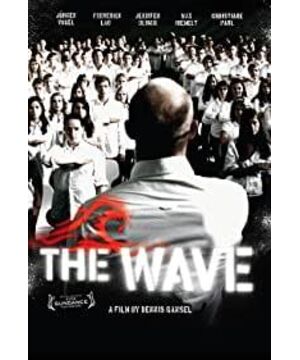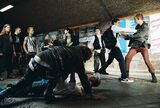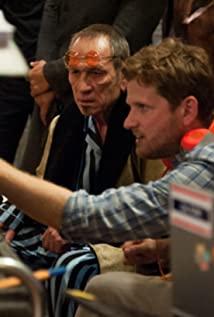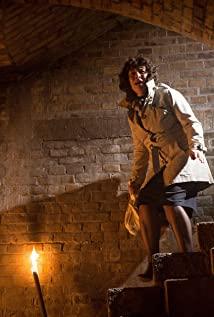- A Comparative Analysis of Dead Poets Society and The Wave
Freedom, "Freedom" or "Liberty" in English, "Freiheitt" in German. The spelling is different, but the meaning is similar. The American film "Dead Poets Society" and the German film "The Tide" have strong comparability because of the discussion of freedom and democracy in the theme, and the themes are the same as campus, education, and teacher-student relationship. There are similarities and differences in the themes, structures, styles, and forms of expression between the two films, which are analyzed as follows.
1. Theme and structure
(1) The themes
of "individual and group", "freedom" and "discipline" appear repeatedly in "Dead Poets Society" and "The Tide". From a broad perspective, the two films The theme is closely related to freedom and democracy.
In the movie "The Tide", Mr. Wengel launched an experiment called "Tide" to make the students realize that "dictatorship" is still possible in the present. In the movie "Dead Poets Society", Mr. Keating opposes immutability, supports difference and diversity, and allows students to cherish time, absorb the essence of life, and pursue their dreams. The enlightening role played by the two teachers in education, and the discussion on education also runs through the theme, especially the last two teachers left, which inevitably reminds me of another education-themed movie "Cow Herding Class". Spring". The value of education and the sadness of education are reflected in these three films. The teacher's departure makes people sigh, but the seeds of ideas have already sprouted in the hearts of students.
From the film itself, the theme is different. "Dead Poets Society" was filmed in 1989, and the story is set in 1959. In 1987, the economic crisis occurred in the United States, and the trend of instant entertainment arose in American society, which is also reflected in the film. In the film, teachers let students pay attention to their inner voice, do what they like to do, and pay attention to the expression and expression of personal thoughts and emotions. Poetry in film is both the promoter of the plot and the carrier of emotional expression. And the German film "The Wave" by Dennis Gansel in 2008. Gansel has a special liking for Nazi themes, and the previous film "Hitler's Boys" was also a Nazi theme. The movie "The Tide" is actually discussing the Nazis and autocratic dictatorships throughout. "Why do we always have to carry guilt endlessly", "This is not a sense of guilt, but a sense of responsibility, our sense of responsibility for history", from the lines of "Wave", we can see that as a German Director, he hopes to convey the Germans' sense of historical responsibility through the film. Although it is based on real events in American classrooms, the film has been printed with a strong German color.
(2) Structure
From the structure of the play, both stories are "reasonable and unexpected". In "Dead Poets Society", Neil chose to commit suicide against his father because he could not fulfill his dream, and Teacher Keating was forced to leave school. In the movie "The Tide", Tim couldn't accept the fact that "The Tide" was disbanded, and ended his life with a pistol, so Mr. Wengel was taken away by the police. The films "The Tide" and "Dead Poets Society" both chose to end with two tragic events, the death of the student and the departure of the teacher, which achieved a shocking and thought-provoking effect.
The success of the two films, to a large extent, is due to the ending of the film, from which we can also see the genius of the screenwriter and director. Both teachers played a role in enlightening students, and indeed brought some changes to students, but society is realistic and imperfect. Like a revolution, something can go wrong in one small place. The uncontrollable factor in the play is the human heart. Whether it is Neil's stubborn father or the paranoid and fragile Tim, they become the incentives and directly lead to the final death. Such death makes people more aware of the difficulty of change and transformation, the cruelty of reality and the hardship of education. This is an effect that a happy ending cannot do.
From the point of view of plot structure, the two films are arranged in a sequential and linear relationship. It is obvious in "The Wave" that from Monday to Saturday, the class has completed the transformation from ordinary students to quasi-Nazi groups, gradually progressing every day. Although "Dead Poets Society" did not explicitly state it, from the perspective of its plot development, it is also a sequential linear narrative.
However, this is also different. "Wave" is narrated strictly according to five days, and the picture with the date is directly used as a transition shot. It shows the rigor and directness of the Germans. As a Hollywood movie, "Dead Poets Society" has put more effort into the plot. For example, the film opens with a school ceremony. The retro room furnishings, the characters' formal costumes, the Scottish bagpipes, and the flag that says "tradition" all make people feel the strong sense of ceremony and traditional atmosphere of the school. This is a very typical background introduction. Considering the arrival of Mr. Keating as the beginning of the story, the film develops at about thirty minutes - Mr. Keating impresses the students by reciting poetry. The film focuses on the eyes of the students, depicting them listening carefully and attentively. The turning point in the story is when the students discover that Mr. Keating is a member of the Dead Poets Society. Mr. Keating told the students, "Dead poets are committed to absorbing the essence of life." In the "Dead Poets Society" gatherings and Mr. Keating's classes, the students are no longer learning machines, but for themselves. Fight for something you like and work hard. Whether it is love, acting dream or interest in writing poetry, everyone is getting better, and the movie has entered its climax. And the final death is a plot twist, unexpected. In a way, the structure of Dead Poets Society is slightly more complicated than that of The Tide.
2. Style
Although the two films both reflect reality, as films shot in different countries with a difference of 30 years, the overall styles of "Dead Poets Society" and "The Tide" are quite different. If The Tide is realism, Dead Poets Society is romanticism to a certain extent.
The presentation of the six days in The Wave is easily reminiscent of a documentary, because the marking and emphasis on time are mostly used in documentary short films. Smoking marijuana, punk-style dressing, and small groups bullying weaker students, the high school in "The Wave" is not as dreamy as an idol drama, but wants to show an "imperfect" high school. Its "Nazi" theme itself is full of realistic criticism.
Dead Poets Society is more romantic. Poetry, as one of the important elements in the film, itself represents a dream. Whether it is Keating or the students reciting poetry over and over again, it makes people feel full of idealism. The classic line in the film "Oh, Captain! My captain!" comes from the American poet Walt Whitman's "Leaves of Grass". Whitman himself is a romantic humanistic poet, emphasizing freedom and democracy. "Oh, captain! My captain!" compares the post-Civil War stormy America to a sailboat, and the leader Lincoln to a captain. The movie uses it ingeniously. The class shrouded in tradition and rules is a sailboat, and Mr. Keating is the captain. The captain in the poem eventually leaves, and so does Mr. Keating in the movie. But leaving does not mean disappearing forever. Just as Lincoln and his great achievements remain in the hearts of Americans, Mr. Keating's free struggle and efforts for the students have been recognized by the students. In the film, the students stood on the table and watched Mr. Keating leave. It was like a poem, magnificent and vivid.
The teacher's departure at the end of "The Tide" is very realistic. The teacher was wearing handcuffs and got into a police car. Teachers and students just watched, some were crying, some were shouting, just like a crime scene in real life. After the teacher got into the police car, there was no dialogue. The picture showed the low trees along the way. The picture turned back to the teacher's face, and the teacher showed a surprised expression. At this moment, the film stopped abruptly. No turnarounds, no surprises, that's what most reality looks like.
3. Expression techniques
Although there are many similarities in the themes of the two films, they are quite different in technical aspects such as camera movement, music, editing, picture style and tone.
(1) Camera motion
Most of the shots in Dead Poets Society are fixed shots, and motion shots are used when a certain emotion needs to be expressed deliberately. I remember a scene where the sun was setting and someone was playing the Scottish bagpipes by the lake. Then there is another fixed shot. The academy under the bell is shrouded in the purple twilight, which is peaceful and solemn. With just two shots, a serious atmosphere is created.
The most impressive thing is that at the 56th minute of the movie, the teacher inspired the students to write poems and asked what kind of person Whitman was. The teacher covered the students' eyes and kept asking questions. The camera rotates as the teacher and students go in circles. The rotating camera is like a student's thinking, and when the student speaks out what he thinks, the camera becomes a fixed one, and he starts to listen carefully to what the student is saying. The teacher's persuasion, the students also said amazing sentences, the students sitting below fell silent, showing their praise and respect for the students with silence. From that moment on, the shy Todd was no longer a man who had no one to listen to. He won respect and applause.
The use of most of the fixed shots is actually consistent with the overall style of "Dead Poets Society". The tone of the film established by the rigorous and ceremonial school and the American setting in 1959 make the fixed shots more suitable for the overall film. .
And "Wave" is much cooler in terms of camera movement. Even explaining the classroom environment, it should be shown by moving the camera, and the dialogues of many characters are also completed while walking. The most distinctive feature of "Wave" is the use of pushing the lens and zooming, which has been used many times in the film. One of them is that Tim was bullied, and the classmates in the class complained about him. One of the classmates wanted to give Tim his phone number, and the camera moved forward, from the middle ground to a close-up of Tim. There are a lot of shots like this in the film that avoid switching. Moreover, this kind of pushing lens gives people a feeling of subjective lens. With the advancement of the lens, we can see the expressions and demeanor of the characters more clearly, as if entering the spiritual world of the characters.
(2) Soundtrack
Whether it is "Dead Poets Society" or "The Tide", the choice of soundtrack has made outstanding contributions to the setting of the background and the development of the plot.
The soundtrack of the film "Dead Poets Society" is mostly classical music. For example, there is a scene in the movie where everyone plays football. Under the setting sun, everyone on the screen is full of spring breeze, and the background music is Ode to Joy. The song and the screen can be said to be the opposite of sound and picture, reflecting the joy and joy of the characters at that time. Excitedly, the students picked up their teacher and ran across the playground, the music reaching its climax. The students in "Dead Poets Society" received the most orthodox and rigorous education in the United States at that time. Although they gradually became ideological, there were some more serious and orthodox thoughts subtly, so it was more appropriate to use classical music.
In order to show the rebelliousness and liveliness of high school students, "Wave" uses a lot of punk rock music, and even in the teacher's initial appearance scene, it is rock music. At the beginning of the film, Mr. Wengel drives the car and sings to the music in the car. The song is from 1979's "Rock'n'Roll High School" by the Ramones, the first punk rock band that contributed a lot to rock and music theory. And this "Rock School" can imply the restlessness of the high school campus and the rebellion of the students to a certain extent. And Mr. Wengel's love for such rock music also shows Mr. Wengel's own unconventional and social class (not high education, self-study degree, participated in the May 1st parade). Later, when students gathered and posted "Wave" stickers, they also used rock music, showing a rebellious and rebellious mentality. And this kind of music actually implies a sense of danger, which makes people inevitably think of violence and murder. In fact, it is also a hint of the reverse ending later.
"Dead Poets Society" is also very careful in the choice of background music. Attention to detail in the depiction and metaphors embodied in the music. In the final scene of Neil's suicide, the director did not explain that Neil committed suicide, but used some gloomy music to make people feel psychologically depressed. There is almost no sound during the same period. The picture shows Neil putting on a garland in slow motion, taking the key, opening the drawer, and taking out an unknown object wrapped in cloth. There was no gunshot, but the music stopped abruptly, and my father woke up from his dream. The father searched for Neil until he found the gun on the ground and the fallen Neil. With the father's "NO!", the music started again, and it was a slow motion again. Neil can be said to have died in peace. Although there was no gunshot, it gave people a shocking power.
(3) Editing
The big difference in the movie style between The Wave and Dead Poets Society comes from the editing of the movie. The editing of some clips in The Wave pursues the expression of individuality, just like the rock music in the movie. "Dead Poets Society" is more traditional and conservative, focusing more on telling a smooth story.
The highlight of "The Wave" in the editing is to quickly edit the picture with the music with a strong sense of rhythm, giving people a dazzling feeling. At the beginning of the film, Mr. Wengel drives, the director shoots with multiple cameras, and then quickly cuts the shots, switching multiple scenes, giving people a cool feeling, which is also a common method in film editing now. In the scene where the students posted stickers at night and sprayed the "Tide" logo, the director also used a lot of fragmented shots. With the intense music rhythm, the scenes showing the students' actions were quickly edited together. When the stickers are pasted on the wall, it is very powerful from the picture. Such repetition implies the power of the students, indicating that they have reached the point of loyalty to the "wave". The editing of "Dead Poets Society" is much more ordinary, it emphasizes the smoothness and no trace of editing. What impressed me the most was that the students did their first "Dead Poets Society" activity. They cut the scenes of the students running in the black forest several times. With some ethereal and supernatural music, it gave people the feeling that these students are in the mountains. The illusion of elves, they have flashlights in their hands, illuminating the light, as if running towards freedom and light.
(4) Tone and picture style
As two films that were filmed a long time apart, "The Wave" and "Dead Poets Society" are completely different in tone and picture style. Most of the pictures in "Dead Poets Society" are grayish in color. Blue, black, and gray are the most common colors in it, and the brightness of these colors is not high, giving people a more depressed and dull feeling. In the choice of character clothing, scenes and props, the director uses black, blue and a little red, which is more formal and serious. In light and shade processing, try to choose a picture with little contrast. In the film, special attention is paid to the naturalness of the lighting on the faces of the characters. Basically, there is no sunlight hitting the face and overexposure. For the treatment of some night scenes, the director did not deliberately illuminate the faces of the actors, but very naturally showed the true state of the faces in the dark night, making the film full of nostalgia.
The picture of the movie "The Wave" is very modern, and the color saturation of the picture is very high. In the lighting of the character's face, there is often direct sunlight on the character's face, causing the character's face to be very bright, which is more in line with current commercial movies. style of. In the choice of scenes, except for a few night scenes, the pictures always look clean, tidy and bright, forming a strong contrast with the retro school in "Dead Poets Society". For example, in the depiction of handball games, spacious stadiums, clean swimming pools, huge floor-to-ceiling glass, and the halo formed by the refraction of underwater sunlight are very in line with people's imagination of high school campuses in developed countries under the modern industrial civilization. In night scenes, there are often headlights, and the dazzling lights contrast with the dark environment, giving people a feeling of instability, which makes people think that these students are doing some "shameful" things.
But whether it is the depression and dullness of "Dead Poets Society" or the full modernity of "The Wave", the director and cameraman are considered from the background of the story and the aesthetic trend. In this regard, the two seem to have similarities. place.
Even today, the pursuit of "freedom" is still an enduring topic, and two films from different periods give us different answers in terms of thematic connotations and shooting techniques. "I stepped into the jungle because I wanted to live meaningfully," Solo said. "I wanted to live deeply, to take all the best out of life, to crush everything that wasn't life, lest when my life ends, I find that I never lived "Dead Poets Society", poetry makes life profound and meaningful. In real life, the movies "The Tide" and "Dead Poets Society", like poetry, let the audience think, pursue, and make life different. The death of freedom, the soul dances alone.
View more about The Wave reviews











